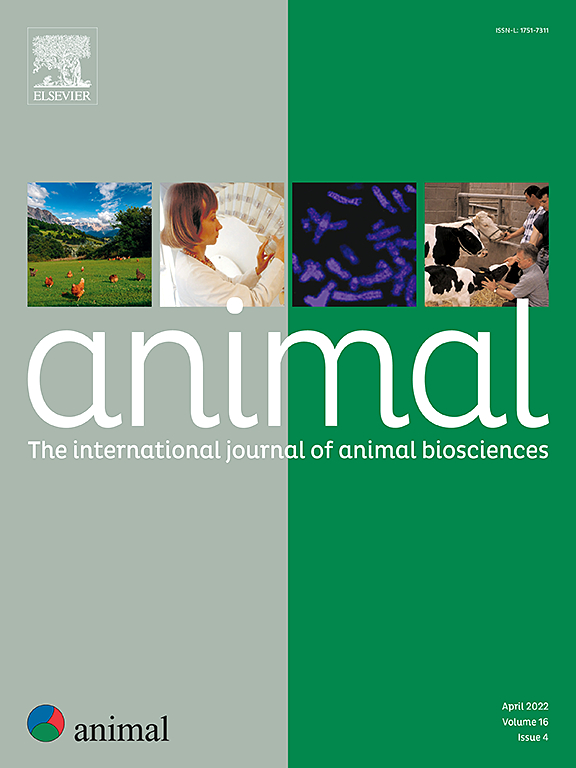Effects of algal supplementation on broiler chicken growth performance, gut development, blood leukocyte counts and antibody levels
IF 4.2
2区 农林科学
Q1 AGRICULTURE, DAIRY & ANIMAL SCIENCE
引用次数: 0
Abstract
Brown macroalgae contains complex polysaccharides including laminarins that have shown prebiotic potential. The aim of this study was to investigate if feeding algal products from Saccharina latissima to either broiler breeders or directly to their chickens could affect growth performance, gut- and immune development in the chickens. A total of 45 hens of the parent line of Ross 308 were used to obtain fertilised eggs. The hens were fed one of three experimental diets, a control, the addition of 0.6% algal meal or addition of 0.08% algal extract. The progenies of those hens were followed in an experiment using a split-plot design where eggs from the three hen treatments were distributed into 24 modules. Half of the modules were assigned a control diet, and half of the modules were a diet supplemented with 725 ppm algal extract. A total of 255 chicks remained after hatching and individual marking, they were weighed at hatch, on days 3, 7, 14, and 37 and blood samples for determination of leukocyte counts and serum antibody levels were drawn on days 3, 7 and 12. Chickens were killed to assess organ development at days 7, 14 and 37, and histological examination of ileal tissue was performed on day 7. The results showed that chicks fed the algal extract diet had higher (P < 0.05) BW on days 3, 7 and 37, a higher proportion of serum immunoglobulin Y (IgY) and a lower proportion of maternal antibodies to infectious bronchitis virus on day 12 (P < 0.05). Chicks fed algal extract showed higher numbers (P < 0.05) of CD4+CD8- helper T-cells and total T-cell receptor (TCR)γ/δ+ T-cells, and among the TCRγ/δ+ T-cell subpopulations, the TCRγ/δ+CD8- T-cells were increased, and lower (P < 0.05) numbers of cluster of differentiation (CD)4+CD8αα+ and TCRγ/δ+CD8αβ+ T-cells in the circulation. Feeding algal extract to the breeders resulted in higher chick BW on day 7, and the villus height−to−crypt depth ratio was higher (P < 0.05) for chicks from hens fed algal extract than for chicks from hens fed algal meal. In conclusion, feeding algal extract from Saccharina latissima directly to the chicken improved growth performance throughout the growing period and altered the composition of T-cell populations in the circulation and may have enhanced the chicks’ IgY production. Maternal supplementation of algal extract to breeder hens had positive effects on the chickens’ early growth performance and gut architecture. However, no synergistic effects of both maternal feeding and direct supplementation to the chicken were found.
添加海藻对肉鸡生长性能、肠道发育、血液白细胞计数和抗体水平的影响
褐藻含有复杂的多糖,包括层状蛋白,显示出益生元的潜力。本研究的目的是探讨肉鸡养殖者或直接饲喂糖精藻产品是否会影响鸡的生长性能、肠道和免疫发育。用罗斯308亲本系的45只母鸡获得受精卵。各组分别饲喂3种试验饲粮,分别为对照组、添加0.6%藻粉或添加0.08%藻提取物。这些母鸡的后代在实验中采用了分块设计,其中三种母鸡处理的鸡蛋被分配到24个模块中。一半的模块被分配为对照饮食,一半模块的饮食中添加了725 ppm的藻类提取物。孵卵后,共留下255只雏鸡,分别于孵化后第3、7、14、37天称重,第3、7、12天采血测定白细胞计数和血清抗体水平。在第7、14和37天处死鸡,评估器官发育情况,并在第7天对回肠组织进行组织学检查。结果表明,饲喂海藻提取物日粮的雏鸡(P <;血清免疫球蛋白Y (IgY)比例升高,第12天母体传染性支气管炎病毒抗体比例降低(P <;0.05)。喂食海藻提取物的雏鸡,其数量更高(P <;0.05) CD4+CD8-辅助性t细胞和总t细胞受体(TCR)γ/δ+ t细胞,在TCRγ/δ+ t细胞亚群中,TCRγ/δ+CD8- t细胞升高,TCRγ/δ+CD8- t细胞降低(P <;0.05)循环中4+CD8αα+和TCRγ/δ+CD8αβ+ t细胞分化簇(cd4 + αα+)的数量。饲喂海藻提取物后,第7天雏鸡体重增加,绒毛高度与隐窝深度比增加(P <;饲喂藻精的雏鸡比饲喂藻粕的雏鸡的差异显著(0.05)。由此可见,在整个生长期,直接饲喂糖精藻提取物可提高鸡的生长性能,改变循环中t细胞群的组成,并可能提高鸡的卵黄产量。母鸡饲粮中添加藻提取物对母鸡的早期生长性能和肠道结构有积极影响。然而,没有发现母饲和直接添加对鸡的协同效应。
本文章由计算机程序翻译,如有差异,请以英文原文为准。
求助全文
约1分钟内获得全文
求助全文
来源期刊

Animal
农林科学-奶制品与动物科学
CiteScore
7.50
自引率
2.80%
发文量
246
审稿时长
3 months
期刊介绍:
Editorial board
animal attracts the best research in animal biology and animal systems from across the spectrum of the agricultural, biomedical, and environmental sciences. It is the central element in an exciting collaboration between the British Society of Animal Science (BSAS), Institut National de la Recherche Agronomique (INRA) and the European Federation of Animal Science (EAAP) and represents a merging of three scientific journals: Animal Science; Animal Research; Reproduction, Nutrition, Development. animal publishes original cutting-edge research, ''hot'' topics and horizon-scanning reviews on animal-related aspects of the life sciences at the molecular, cellular, organ, whole animal and production system levels. The main subject areas include: breeding and genetics; nutrition; physiology and functional biology of systems; behaviour, health and welfare; farming systems, environmental impact and climate change; product quality, human health and well-being. Animal models and papers dealing with the integration of research between these topics and their impact on the environment and people are particularly welcome.
 求助内容:
求助内容: 应助结果提醒方式:
应助结果提醒方式:


